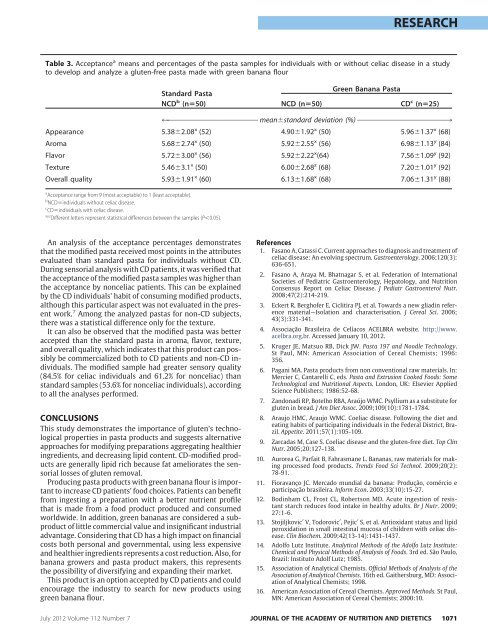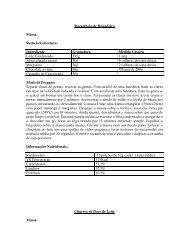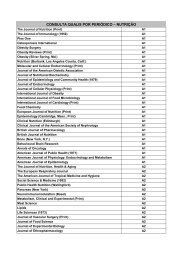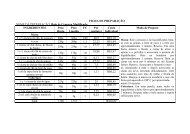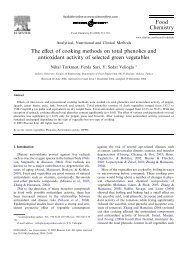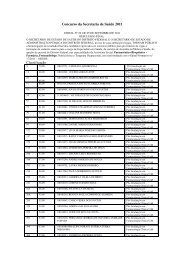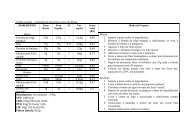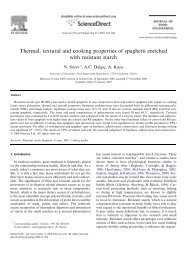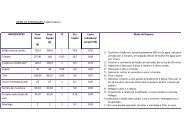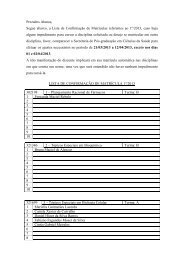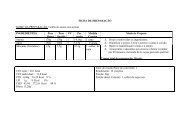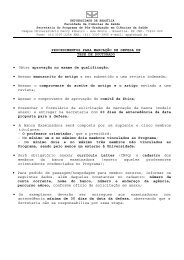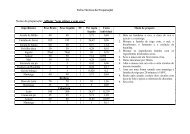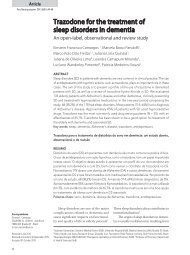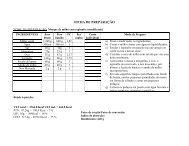Green Banana Pasta: An Alternative for Gluten-Free Diets
Green Banana Pasta: An Alternative for Gluten-Free Diets
Green Banana Pasta: An Alternative for Gluten-Free Diets
Create successful ePaper yourself
Turn your PDF publications into a flip-book with our unique Google optimized e-Paper software.
Table 3. Acceptance a means and percentages of the pasta samples <strong>for</strong> individuals with or without celiac disease in a study<br />
to develop and analyze a gluten-free pasta made with green banana flour<br />
Standard <strong>Pasta</strong><br />
NCD b (n50)<br />
<strong>An</strong> analysis of the acceptance percentages demonstrates<br />
that the modified pasta received most points in the attributes<br />
evaluated than standard pasta <strong>for</strong> individuals without CD.<br />
During sensorial analysis with CD patients, it was verified that<br />
the acceptance of the modified pasta samples was higher than<br />
the acceptance by nonceliac patients. This can be explained<br />
by the CD individuals’ habit of consuming modified products,<br />
although this particular aspect was not evaluated in the present<br />
work. 7 Among the analyzed pastas <strong>for</strong> non-CD subjects,<br />
there was a statistical difference only <strong>for</strong> the texture.<br />
It can also be observed that the modified pasta was better<br />
accepted than the standard pasta in aroma, flavor, texture,<br />
and overall quality, which indicates that this product can possibly<br />
be commercialized both to CD patients and non-CD individuals.<br />
The modified sample had greater sensory quality<br />
(84.5% <strong>for</strong> celiac individuals and 61.2% <strong>for</strong> nonceliac) than<br />
standard samples (53.6% <strong>for</strong> nonceliac individuals), according<br />
to all the analyses per<strong>for</strong>med.<br />
CONCLUSIONS<br />
This study demonstrates the importance of gluten’s technological<br />
properties in pasta products and suggests alternative<br />
approaches <strong>for</strong> modifying preparations aggregating healthier<br />
ingredients, and decreasing lipid content. CD-modified products<br />
are generally lipid rich because fat ameliorates the sensorial<br />
losses of gluten removal.<br />
Producing pasta products with green banana flour is important<br />
to increase CD patients’ food choices. Patients can benefit<br />
from ingesting a preparation with a better nutrient profile<br />
that is made from a food product produced and consumed<br />
worldwide. In addition, green bananas are considered a subproduct<br />
of little commercial value and insignificant industrial<br />
advantage. Considering that CD has a high impact on financial<br />
costs both personal and governmental, using less expensive<br />
and healthier ingredients represents a cost reduction. Also, <strong>for</strong><br />
banana growers and pasta product makers, this represents<br />
the possibility of diversifying and expanding their market.<br />
This product is an option accepted by CD patients and could<br />
encourage the industry to search <strong>for</strong> new products using<br />
green banana flour.<br />
<strong>Green</strong> <strong>Banana</strong> <strong>Pasta</strong><br />
NCD (n50) CD c (n25)<br />
4 meanstandard deviation (%) 3<br />
Appearance 5.382.08 x (52) 4.901.92 x (50) 5.961.37 x (68)<br />
Aroma 5.682.74 x (50) 5.922.55 x (56) 6.981.13 y (84)<br />
Flavor 5.723.00 x (56) 5.922.22 x (64) 7.561.09 y (92)<br />
Texture 5.463.1 x (50) 6.002.68 z (68) 7.201.01 y (92)<br />
Overall quality 5.931.91 x (60) 6.131.68 x (68) 7.061.31 y (88)<br />
aAcceptance range from 9 (most acceptable) to 1 (least acceptable).<br />
bNCDindividuals without celiac disease.<br />
cCDindividuals with celiac disease.<br />
xyzDifferent letters represent statistical differences between the samples (P0.05).<br />
RESEARCH<br />
References<br />
1. Fasano A, Catassi C. Current approaches to diagnosis and treatment of<br />
celiac disease: <strong>An</strong> evolving spectrum. Gastroenterology. 2006;120(3):<br />
636-651.<br />
2. Fasano A, Araya M, Bhatnagar S, et al. Federation of International<br />
Societies of Pediatric Gastroenterology, Hepatology, and Nutrition<br />
Consensus Report on Celiac Disease. J Pediatr Gastroenterol Nutr.<br />
2008;47(2):214-219.<br />
3. Eckert R, Berghofer E, Ciclitira PJ, et al. Towards a new gliadin reference<br />
material—Isolation and characterisation. J Cereal Sci. 2006;<br />
43(3):331-341.<br />
4. AssociaÈÄo Brasileira de CelÎacos ACELBRA website. http://www.<br />
acelbra.org.br. Accessed January 10, 2012.<br />
5. Kruger JE, Matsuo RB, Dick JW. <strong>Pasta</strong> 197 and Noodle Technology.<br />
St Paul, MN: American Association of Cereal Chemists; 1996:<br />
356.<br />
6. Pagani MA. <strong>Pasta</strong> products from non conventional raw materials. In:<br />
Mercier C, Cantarelli C, eds. <strong>Pasta</strong> and Extrusion Cooked Foods: Some<br />
Technological and Nutritional Aspects. London, UK: Elsevier Applied<br />
Science Publishers; 1986:52-68.<br />
7. Zandonadi RP, Botelho RBA, AraÛjo WMC. Psyllium as a substitute <strong>for</strong><br />
gluten in bread. J Am Diet Assoc. 2009;109(10):1781-1784.<br />
8. Araujo HMC, Araujo WMC. Coeliac disease. Following the diet and<br />
eating habits of participating individuals in the Federal District, Brazil.<br />
Appetite. 2011;57(1):105-109.<br />
9. Zarcadas M, Case S. Coeliac disease and the gluten-free diet. Top Clin<br />
Nutr. 2005;20:127-138.<br />
10. Aurorea G, Parfait B, Fahrasmane L. <strong>Banana</strong>s, raw materials <strong>for</strong> making<br />
processed food products. Trends Food Sci Technol. 2009;20(2):<br />
78-91.<br />
11. FioravanÈo JC. Mercado mundial da banana: ProduÈÄo, comÊrcio e<br />
participaÈÄo brasileira. In<strong>for</strong>m Econ. 2003;33(10):15-27.<br />
12. Bodinham CL, Frost CL, Robertson MD. Acute ingestion of resistant<br />
starch reduces food intake in healthy adults. Br J Nutr. 2009;<br />
27:1-6.<br />
13. Stojiljkovic´ V, Todorovic´, Pejic´ S, et al. <strong>An</strong>tioxidant status and lipid<br />
peroxidation in small intestinal mucosa of children with celiac disease.<br />
Clin Biochem. 2009;42(13-14):1431-1437.<br />
14. Adolfo Lutz Institute. <strong>An</strong>alytical Methods of the Adolfo Lutz Institute:<br />
Chemical and Physical Methods of <strong>An</strong>alysis of Foods. 3rd ed. SÄo Paulo,<br />
Brazil: Instituto Adolf Lutz; 1985.<br />
15. Association of <strong>An</strong>alytical Chemists. Official Methods of <strong>An</strong>alysis of the<br />
Association of <strong>An</strong>alytical Chemists. 16th ed. Gaithersburg, MD: Association<br />
of <strong>An</strong>alytical Chemists; 1998.<br />
16. American Association of Cereal Chemists. Approved Methods. St Paul,<br />
MN: American Association of Cereal Chemists; 2000:10.<br />
July 2012 Volume 112 Number 7 JOURNAL OF THE ACADEMY OF NUTRITION AND DIETETICS 1071


